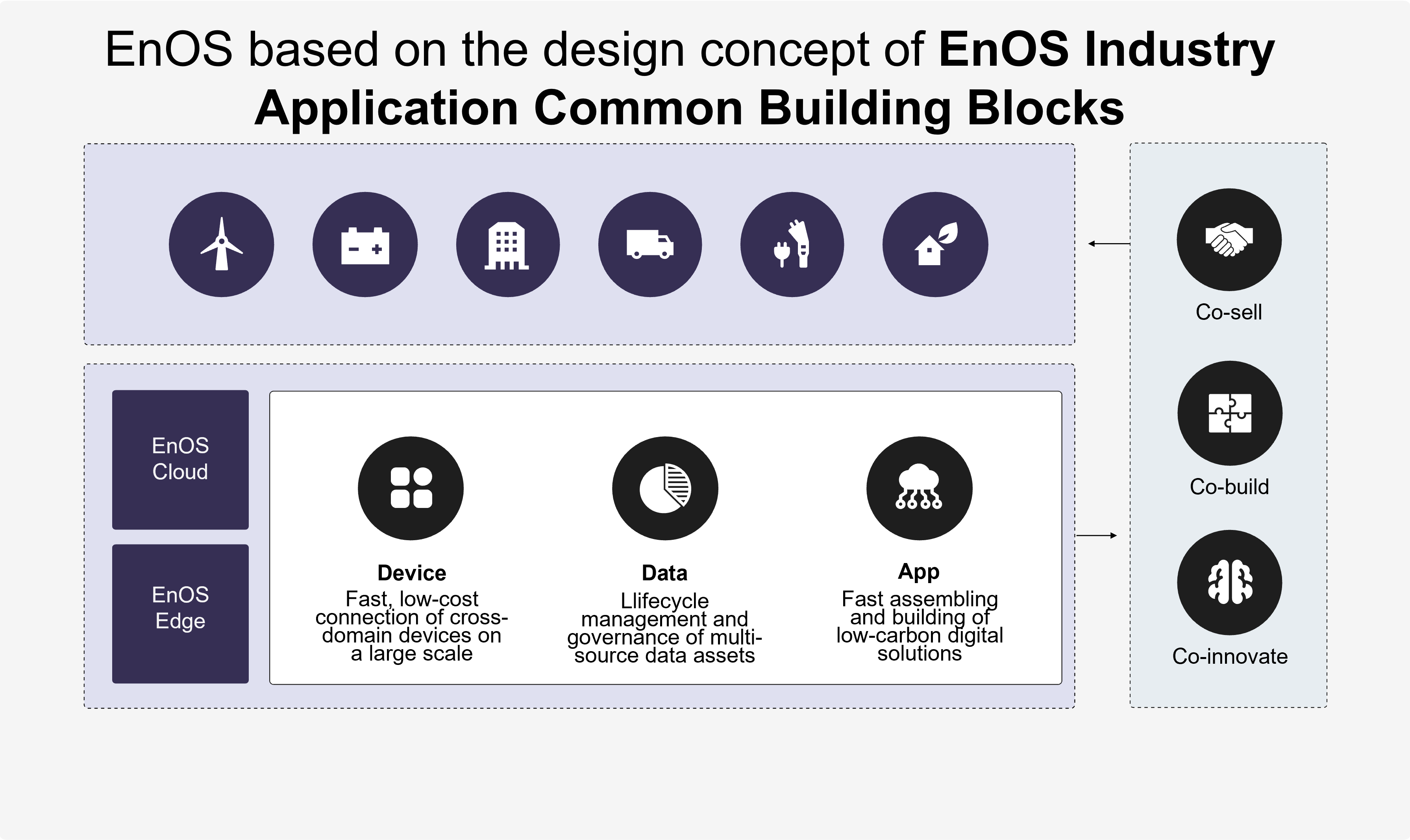What is EnOS?¶
EnOS is a purpose-built IoT platform that aims to fuel your digitalization and decarbonization journey with an integrated solution suite. Built on open standards and proven technology, its design incorporates operation best practices in renewable energy, smart cities, grids and other vertical domains with expertise in energy management, carbon management, and asset management. It provides efficient and cost-effective connectivity and management for large scale complex devices and helps organizations efficiently and agilely innovate and develop their ecosystems based on out-of-the-box software and an open platform that is configurable and customizable.

EnOS can be deployed on edge or in the cloud. Its end-to-end design helps to flexibly address heterogeneous connectivity adaptation, edge computing, distributed edge control scenarios at the edge and centralized management operations across geographies and domains in the cloud.
EnOS provides rich native applications for energy, carbon, and asset management, accelerating digitalization and decarbonization journey of energy-intensive industries such as energy & utility sectors, manufacturing, transportation, and building. EnOS is built on a Common Building Block (CBB) philosophy, designed to bridge IT and OT expertise by abstracting business scenarios into configurable packaged business capabilities. This approach empowers business personnel (citizen developers) to create composable industry applications using industry templates and domain libraries available in EnOS.

EnOS core capabilities include device connectivity and management, data management and analytics, and application enablement, supporting both EnOS native applications and custom applications built using the capabilities.
Device Connectivity and Management¶
Many enterprises are stuck or are encountering big challenges at the gate of IoT solution adoption due to connectivity, as the heterogeneous devices and sensors deployed in different networking environments communicate in various protocols. Furthermore, the data to connect to does not only reside in device assets, but also reside in different systems to be connected to unlock the synergistic value.
EnOS Device Connectivity and Management helps shield the heterogeneity of devices and complexity of connection scenarios and enables devices of various domains to be connected to EnOS efficiently, securely, and with high data quality. By enabling secure and reliable connectivity, EnOS manages vast amount of IoT devices from the cloud to achieve O&M transparency, predictive maintenance, and performance optimization through full device lifecycle management on EnOS.
For more information, see EnOS Device Connectivity and Management.
Data Management¶
While large-scale IoT and non-IoT data management offers enterprises the advantage of interconnected data, it also presents significant challenges. EnOS Data Management is designed to simplify the management of structured and unstructured data across various datastores, including time-series databases, relational databases, and graph databases. This streamlines data access and discovery, enabling organizations to handle massive data volumes, improve access speeds, and manage diverse data types effectively.
EnOS Data Management provides end-to-end governance across the entire data lifecycle—from ingestion and processing to storage and sharing. It optimizes data storage solutions for high-performance acquisition of large-scale data and leverages advanced analytics tools to generate insights, explore new business models, and support informed business decisions.
For more information, see EnOS Data Management.
Application Building¶
EnOS simplifies application development by encapsulating the complexity of underlying technologies and reducing barriers through a loosely coupled microservices architecture. This architecture enables rapid building, deployment, and scaling of applications using IoT data. EnOS Application Building consists of two key components: Industry Application Common Building Blocks(CBBs) and the Advanced Application Development Capabilities.
Industry Application Common Building Blocks¶
Industry Application Common Building Blocks abstract common application scenarios into configurable templates with embedded business semantics, such as device models, asset topology models, and industry analysis models. The templates are designed for visualization and ease of use.
The components enable business users to quickly build applications by using low-code tools and templates to meet specific business needs. Applications developed with CBBs can be accessed from the EnOS Application Portal, offering a consistent user interface experience. Additionally, the business semantic data behind configured templates can be accessed by professional developers through APIs, extending the functionality for advanced use cases.
Key benefits of Industry Application CBBs:
Configurable Applications: EnOS native applications can be rapidly configured and published without coding, enabling efficient customization to meet individual needs.
Empowering Non-IT Users: Business users familiar with application scenarios and logic can build applications such as visualization dashboards, reports, asset monitoring, and alarms without relying on professional IT staff.
Advanced Application Development Capabilities¶
The advanced Application Development capabilities are designed for collaborative innovation, supporting professional developers in building advanced, custom applications. Unlike CBBs, which focus on no-code or low-code development, these capabilities provide powerful tools, including APIs, SDKs, and other developer-centric capabilities.
Key benefits of the advanced application development capabilities:
Comprehensive APIs and SDKs for professional development, with an application deployment pipeline that streamlines DevOps from build to runtime in the EnOS container cluster.
Flexibility to create fully customized applications that complement or extend the applications built with CBBs.
For more information, see EnOS Application Building.